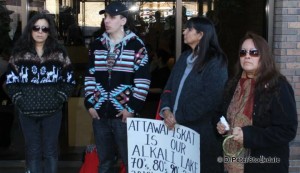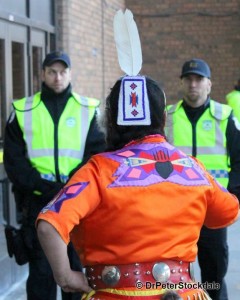by Matt Cicero

A group of 50 people belonging to the Occupy INAC movement marched from Parliament Hill to Indigenous and Northern Affairs Canada (INAC) on the morning of Friday, April 15.This rally was an act of solidarity with the Cree community of Attawapiskat, where there have been more than 50 suicide attempts in the past seven weeks.
On April 14, INAC offices in Toronto were occupied by a group calling themselves Ground Zero INAC Toronto. Since then there have been actions and occupations in Calgary, Edmonton, Quebec, Gatineau, Regina, Winnipeg and Vancouver.
According to their Twitter feed, INAC’s Regional offices in Toronto, Winnipeg, Regina and their Status Card office in Ottawa were all closed on Friday in response to protests. INAC Offices in Toronto, Winnipeg, and Vancouver were occupied by protesters.
On Thursday, April 21, Ground Zero INAC Toronto ended their occupation with a rally. “The Youth of Attawapiskat have let us know that they are satisfied with the meeting that took place on Monday with Federal MP’s and the Regional Director of INAC,” according to a statement posted on the group’s Facebook page.
On Saturday, April 23, Occupy INAC in Vancouver Coast Salish Territories ended their own occupation after they secured a meeting with both Minister of Indigenous and Northern Affairs Carolyn Bennett and Minister of Canadian Heritage Mélanie Joly to discuss their demands.
The catalyst for these protests was a declaration of a state of emergency by the Chief and Council of Attawapiskat who said they are overwhelmed by the number of suicide attempts. Since 2006, Attawapiskat has declared four other states of emergency: in 2006 over the deteriorating quality of drinking water; in 2009 homes were contaminated by sewage; in 2011 for a severe housing shortage; and in 2013 due to flooding and sewer backups.
Occupy INAC Ottawa on Algonquin Territory

At the INAC offices at Terrasses de la Chaudière in Gatineau, police and security guards were on site and secured the building’s entrances ahead of the protest. Gatineau police refused to let the protesters enter the building.
Several speeches were delivered outside of INAC headquarters.
Jocelyn Iahtail, a Cree woman from Attawapiskat who now lives in Ottawa, spoke against “intergenerational child warfare with the Indian Residential Schools and child welfare.” She demanded that the Liberal government uphold the apology for the Residential School system and “honour that apology, because everything that you did to my parents, you’re doing to my children as well.”
Currently there are three times more Indigenous children in the custody of state-run child welfare agencies, such as the Children’s Aid Society, than there were at the height of the residential school system.
After the speeches, there was sporadic drumming and singing until the protest ended in the mid-afternoon.
Four protesters were eventually permitted to enter the building to speak with an INAC representative. However, they were told by Sheila Murphy, the Assistant Deputy Minister of Lands & Economic Development, that they would have to wait until Tuesday for a meeting.
It’s Politics Time Again
In a statement released on Friday, April 15, Carolyn Bennett, Minister of INAC, and Charlie Angus, NDP critic for Indigenous and Northern Affairs, said that they “will be visiting the community on Monday.” They also said that “Officials have been working…to provide mental health and community supports to Attawapiskat and the individuals and families in need,” and they are working on “longer term solutions.”
“Federal and provincial partners and the First Nation all have dedicated people working on a priority basis on these issues,” the statement continued.
In a 2016 report by the Mushkegowuk Council, which represents the Cree First Nations of Attawapiskat, Chapleau, Fort Albany, Kashechewan, Missanabie, Moose Cree and Taykwa Tagamou issued a report entitled “Nobody Wants to Die. They Want the Pain to Stop.” In the report, the authors wrote that the Mushkegowuk Council had completed and submitted a Regional Crisis Response Plan to the suicide epidemic in their communities in 2010. However, the necessary funding was denied as “the plan was not approved by the Federal and Provincial Health Authorities.”
This is not even the first time that suicide has caused Cree leaders to declare a state of emergency. In May 2010, Grand Chief Stan Louttit of the Mushkegowuk Council declared a state of emergency in response to the ongoing epidemic of suicide on all of the reserves represented by the Council.
“they have to move, like anybody else”
When Jean Chretien’s said that “[t]here is no economic base there for having jobs and so on, and sometimes they have to move, like anybody else,” he was expressing common-sense colonialism. However, the Cree of Attawapiskat are not simply like any other settler Canadians. They have Aboriginal and Treaty rights stemming from Creator, the Canadian Charter of Rights and Freedoms, and from their adhesion in 1930 to Treaty Nine, and one of these rights is to live on their territory and to practice their culture and traditions
Furthermore, De Beers, a global diamond mining consortium, operates the highly profitable Victor Diamond Mine — $400 million a year, according to APTN — in Attawapiskat’s traditional territory. In a 2009 Intercontinental Cry Magazine article, Grand Chief Stan Louttit, said that Attawapiskat “is benefiting only a little. We’re still in poverty, we’re still overcrowded.” Little has changed since Grand Chief Louttit’s statement seven years ago.
In his 2013 article “Canada: Prime Minister Harper Launches First Nations ‘Termination Plan’” Mohawk policy analyst Russell Diabo wrote “for the last twenty years, the federal government — whether Liberal or Conservative — has continued to develop policies and legislation based upon the White Paper/Buffalo Jump objectives [to assimilate First Nations people].”
The state of emergency in Attawapiskat, and the crises level of suicide in the region and in many First Nations communities must be understood against this backdrop of Federal and Provincial efforts to assimilate First Nations.
Indeed, as Ground Zero INAC Toronto said in their April 14 press release, “Canada has been well aware of the high youth suicide rates in First Nation and Inuit communities nationwide. This is suicide by neglect.”
Or, as protestors in Gatineau put it, “Suicide is genocide.”





